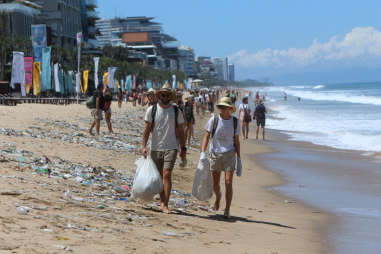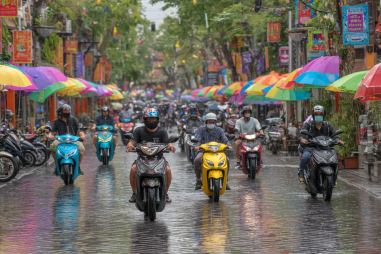Tanah Lot Temple is one of Bali’s most iconic sea temples, renowned for its stunning location perched atop a rocky outcrop against the crashing waves of the Indian Ocean. More than just a tourist attraction, this temple holds deep spiritual significance. However, like many treasured natural and cultural sites around the world, Tanah Lot faces significant environmental challenges that threaten its integrity and longevity. Understanding these issues and the preservation efforts underway provides insight into how this sacred site can be protected for future generations while balancing tourism and nature.
Environmental Issues Affecting Tanah Lot
Tanah Lot, naturally exposed to the forces of the ocean, continually faces environmental stressors that accelerate its erosion and degrade its surrounding ecosystem. The temple’s foundation is built on limestone rock that is vulnerable to weathering caused by saline water, wind, and storms. Coastal erosion has been a persistent problem, gradually wearing away the rocky base and putting the structural stability of the temple at risk.
Another important concern is pollution from nearby areas affecting water quality. Runoff from agricultural lands, residential waste, and litter from tourists impact the marine life and coastal health around Tanah Lot. Moreover, climate change brings rising sea levels and more frequent extreme weather events, intensifying the threats posed by natural elements and further stressing the fragile environment surrounding the temple.
Impact of Tourism and Natural Erosion
Tourism plays a vital economic role for the local community, drawing millions to this mystical temple each year. However, the sheer volume of visitors generates pressures on the site’s infrastructure and environment. Unregulated foot traffic, especially during peak seasons and cultural ceremonies, accelerates wear on pathways and the natural rock formations.
Trash and plastic waste left behind can contaminate the beach and ocean, harming wildlife and disrupting the ecological balance. Additionally, the development of facilities to accommodate tourism, such as parking lots, shops, and restaurants, sometimes encroaches on natural areas, impacting soil stability and contributing to erosion.
Natural erosion processes, compounded by human activities, create ongoing challenges to maintaining the temple’s physical integrity and the health of the surrounding ecosystems, necessitating both immediate and long-term preservation efforts.
Conservation Projects and Organizations Involved
Recognizing the urgent need to protect Tanah Lot, various conservation projects have been initiated by government bodies, environmental NGOs, and cultural heritage organizations. The Bali Provincial Government, in collaboration with the local community and stakeholders such as the Indonesian Ministry of Culture and Tourism, has launched restoration and coastal protection programs.
Key projects have involved:
- Reinforcement of the temple’s rock foundation using modern engineering techniques combined with traditional Balinese construction methods to ensure authenticity.
- Installation of seawalls and artificial reefs to reduce wave impact and prevent further erosion.
- Regular cleaning campaigns and marine biodiversity monitoring to maintain ecological balance and address pollution.
- Development of sustainable tourism guidelines and infrastructure improvements to manage visitor flow and reduce environmental stress.
Environmental NGOs, such as the Bali Environment Group and local Ciliwung Waterkeeper teams, actively participate by conducting research, awareness programs, and advocating for stronger environmental policies protecting coastal zones.
Community Participation in Preservation
The local community is central to the success of preservation efforts at Tanah Lot. The temple itself is deeply connected to the Balinese Hindu culture, with local priests and villagers involved in rituals and daily temple upkeep. Community stewardship extends to managing waste, guiding tourists towards responsible behavior, and participating in coastal clean-up activities.
Traditional knowledge also plays a vital role. Local wisdom about the ocean, weather patterns, and spiritual practices informs conservation methods and helps integrate modern preservation techniques with cultural values. Educational programs for residents and youth focus on environmental awareness and the importance of safeguarding cultural heritage alongside natural resources.
How Visitors Can Help Protect the Area
Visitors to Tanah Lot can contribute significantly to its preservation by adopting responsible behaviors during their visit. Here are some practical ways tourists can help:
- Avoid littering and dispose of waste in designated bins.
- Respect restricted areas to prevent damage to sensitive rock formations and vegetation.
- Use eco-friendly products and minimize plastic usage.
- Support local businesses that prioritize sustainable practices.
- Follow guidelines provided by temple caretakers and conservation staff.
- Participate in environmental education sessions, if available, to gain a deeper appreciation of the site’s significance.
By being mindful and respectful of Tanah Lot’s environmental and cultural values, visitors help reduce human impact and preserve the temple’s beauty and sanctity.
Success Stories and Ongoing Challenges
Over the past decade, significant progress has been made in protecting Tanah Lot from the worst effects of erosion and pollution. Engineering reinforcements have successfully stabilized key sections of the temple, and community-led clean-ups have noticeably improved beach conditions. Tourist management reforms have also led to a more organized visitor experience, reducing overcrowding during high seasons.
Nevertheless, challenges remain. Climate change continues to pose an unpredictable threat, with rising sea levels and storm surges demanding ongoing adaptation and investment. The local economy’s dependence on tourism means balancing economic benefits with environmental stewardship requires constant attention and innovation.
Additionally, expanding urbanization in nearby areas threatens to increase pollution and habitat disruption, pressing the need for coordinated regional environmental planning. Continuous education, stricter enforcement of regulations, and active community engagement are essential to ensure the temple’s preservation over the long term.
Nurturing the Legacy Through Sustainable Tourism
The future of Tanah Lot Temple depends heavily on sustainable tourism — a respectful approach that prioritizes environmental preservation alongside cultural respect and economic viability. Protecting this iconic sea temple requires a shared commitment from governments, communities, visitors, and conservationists alike.
When travelers approach Tanah Lot with awareness and care, they become part of a collective effort to maintain not only a stunning landmark but also a sacred site rich with spiritual and ecological significance. By supporting sustainable practices, visitors help ensure that Tanah Lot continues to inspire awe and reverence for generations to come.







